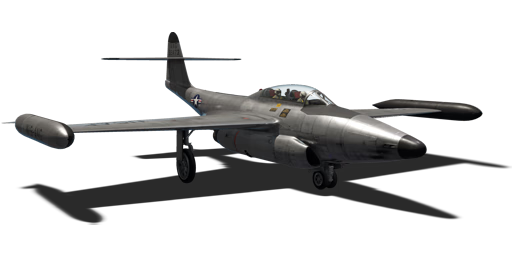



The F-89B Scorpion was designed and built to be an all-weather interceptor intended to neutralize any potential invading Soviet bomber force. The USAAF was intent on replacing the P-61 Black Widow with another night fighter, specifically one which would fly faster (minimum 850 km/h (530 mph)) almost assuredly requiring the usage of jets, and be armed with six .60 calibre (15 mm) machine guns or 20 mm autocannons and internally stored aerial rockets. To round out the aircraft for ground attack if needed, it would also need to be able to accommodate 1,000 lb bombs and eight larger rocket types externally. Initial wind tunnel testing of the fighter determined that the proposed swept wings were insufficient at slow speeds and were changed out with straight wings. Though causing a loss of high-end performance, increased stability at low speeds was necessary. The F-89B was a direct upgrade over the F-89A, featuring mostly upgraded avionics, while the rest of the aircraft remained the same. It was designed to intercept early jet-powered bombers, and it was fitted with an afterburner, which was not very common for the time. Other changes to the horizontal stabilizer also increased the effectiveness of the elevators and rudder. Concerns about the fuel tanks situated right over the engines were nullified when it was determined that efforts made by Northrop to protect them were considered sufficient, anything else would have required a complete redesign of the aircraft.
It was introduced in Update 1.91 "Night Vision". As an interceptor, the F-89B was well suited to have the six nose-mounted cannons which did not require the pilot to have to worry about convergence, especially when flying at higher speeds. The tightly packed cannons concentrated the 20 mm rounds in a tight pattern and when fired in bursts can unleash devastation on both enemy bomber and fighter aircraft, especially suited for head-ons or even strafing runs aimed at the wings or engine sections of the aircraft. While there are only 200 rounds per gun (1,200 total), they are not meant for the pilot to just hold the trigger and spray but instead require a bit of trigger control and fire in short bursts as typically it does not take much to disable or destroy another aircraft. The F-89B is a fairly large aircraft and can be an easy target for other aircraft, so speed is key to maintain manoeuvrability and make it difficult for an enemy fighter to get a positive gun solution on the Scorpion. Boom & Zoom tactics will be the best bet for this fighter as while it is a stable flyer when going slow, it, however, will be an easy target and slow manoeuvring aircraft without the advantage of speed.
flaps
flaps
flaps
brake
| Belt | Belt filling | Armor penetration (mm) at a distance: | |||||
|---|---|---|---|---|---|---|---|
| 10 m | 100 m | 500 m | 1000 m | 1500 m | 2000 m | ||
| AP-T/HEF-I/HEF-I | 36 | 33 | 23 | 15 | 9 | 6 | |
| AP-T/HEF-I/I | 36 | 33 | 23 | 15 | 9 | 6 | |
| HEF-I/HEF-I/I/AP-T | 36 | 33 | 23 | 15 | 9 | 6 | |
| AP-T/AP-I/AP-I/AP-I | 36 | 33 | 23 | 15 | 9 | 6 | |
| HEF-I/AP-I/HEF-I/I | 36 | 33 | 22 | 14 | 9 | 5 | |







 2 x (130 / 340 / 600) %
2 x (130 / 340 / 600) % 
 2 x 202 %
2 x 202 % 

Flight performance | |
|---|---|
Survivability |
|---|
Weaponry |
|---|